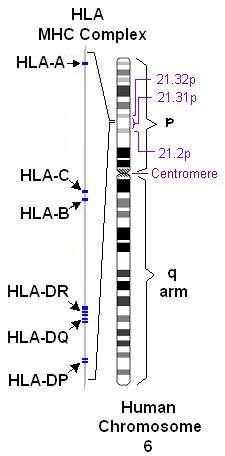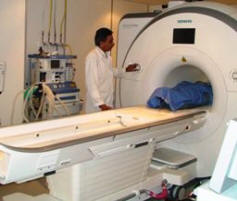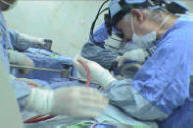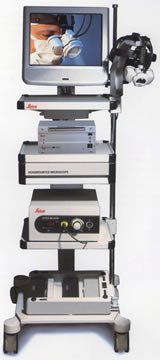|
The overall prognosis of each form is unpredictable, with a
high degree of variability in the final outcome, but the patient
invariably progresses toward an irrecoverable disability.
The widely accepted diagnostic criteria of MS classify individuals
in the categories of MS, possible MS, or not MS. This incorporates
evidence from conventional MRI, which has a very relevant role in
diagnosing and monitoring MS patients. For example, individuals must
have a minimum of two attacks (affecting more than one anatomical
site) to meet the diagnosis of definite MS (“lesions disseminated in
time and space”). Assuming an initial clinical presentation
suggestive of MS (the so-called clinically isolated syndrome, or
CIS), the second attack does not need to be clinically expressed
necessarily, but can be represented by a brain lesion as documented
on conventional MRI. Recently, the MRI diagnostic criteria for MS
have been further revised, to further improve the final diagnosis of
the different forms of MS. Multiple sclerosis
(MS), also known as disseminated sclerosis or encephalomyelitis
disseminata, is an inflammatory disease in which the insulating
covers of nerve cells in the brain and spinal cord are damaged. This
damage disrupts the ability of parts of the nervous system to
communicate, resulting in a wide range of signs and symptoms,
including physical, mental, and sometimes psychiatric problems. MS
takes several forms, with new symptoms either occurring in isolated
attacks (relapsing forms) or building up over time (progressive
forms). Between attacks, symptoms may go away completely; however,
permanent neurological problems often occur, especially as the
disease advances.
While the cause is not clear, the underlying mechanism is thought to
be either destruction by the immune system or failure of the
myelin-producing cells. Proposed causes for this include genetics
and environmental factors such as infections. MS is usually
diagnosed based on the presenting signs and symptoms and the results
of supporting medical tests.
There is no known cure for multiple sclerosis. Treatments attempt to
improve function after an attack and prevent new attacks.
Medications used to treat MS while modestly effective can have
adverse effects and be poorly tolerated. Many people pursue
alternative treatments, despite a lack of evidence. The long-term
outcome is difficult to predict, with good outcomes more often seen
in women, those who develop the disease early in life, those with a
relapsing course, and those who initially experienced few attacks.
Life expectancy is 5 to 10 years lower than that of an unaffected
population.
As of 2008, between 2 and 2.5 million people are affected globally
with rates varying widely in different regions of the world and
among different populations. The disease usually begins between the
ages of 20 and 50 and is twice as common in women as in men. The
name multiple sclerosis refers to scars (sclerae—better known as
plaques or lesions) in particular in the white matter of the brain
and spinal cord. MS was first described in 1868 by Jean-Martin
Charcot. A number of new treatments and diagnostic methods are under
development. Signs and
Symptoms: A person with MS can have
almost any neurological symptom or sign; with autonomic, visual,
motor, and sensory problems being the most common. The specific
symptoms are determined by the locations of the lesions within the
nervous system, and may include loss of sensitivity or changes in
sensation such as tingling, pins and needles or numbness, muscle
weakness, very pronounced reflexes, muscle spasms, or difficulty in
moving; difficulties with coordination and balance (ataxia);
problems with speech or swallowing, visual problems (nystagmus,
optic neuritis or double vision), feeling tired, acute or chronic
pain, and bladder and bowel difficulties, among others. Difficulties
thinking and emotional problems such as depression or unstable mood
are also common. Uhthoff's phenomenon, a worsening of symptoms due
to exposure to higher than usual temperatures, and Lhermitte's sign,
an electrical sensation that runs down the back when bending the
neck, are particularly characteristic of MS. The main measure of
disability and severity is the expanded disability status scale
(EDSS), with other measures such as the multiple sclerosis
functional composite being increasingly used in research.
The condition begins in 85% of cases as a clinically isolated
syndrome over a number of days with 45% having motor or sensory
problems, 20% having optic neuritis, and 10% having symptoms related
to brainstem dysfunction, while the remaining 25% have more than one
of the previous difficulties. The course of symptoms occurs in two
main patterns initially: either as episodes of sudden worsening that
last a few days to months (called relapses, exacerbations, bouts,
attacks, or flare-ups) followed by improvement (85% of cases) or as
a gradual worsening over time without periods of recovery (10-15% of
cases). A combination of these two patterns may also occur or people
may start in a relapsing and remitting course that then becomes
progressive later on. Relapses are usually not predictable,
occurring without warning. Exacerbations rarely occur more
frequently than twice per year. Some relapses, however, are preceded
by common triggers and they occur more frequently during spring and
summer.[15] Similarly, viral infections such as the common cold,
influenza, or gastroenteritis increase their risk. Stress may also
trigger an attack. Women with MS who become pregnant experience
fewer relapses; however, during the first months after delivery the
risk increases. Overall, pregnancy does not seem to influence
long-term disability. Many events have not been found to affect
relapse rates including vaccination, breast feeding, physical
trauma, and Uhthoff's phenomenon.
Causes The cause
of MS is unknown; however, it is believed to occur as a result of
some combination of environmental factors such as infectious agents
and genetics. Theories try to combine the data into likely
explanations, but none has proved definitive. While there are a
number of environmental risk factors and although some are partly
modifiable, further research is needed to determine whether their
elimination can prevent MS.
Geography & Epidemiology MS is
more common in people who live farther from the equator, although
exceptions exist. These exceptions include ethnic groups that are at
low risk far from the equator such as the Samis, Amerindians,
Canadian Hutterites, New Zealand Māori, and Canada's Inuit, as well
as groups that have a relatively high risk close to the equator such
as Sardinians, Palestinians and Parsis. The cause of this
geographical pattern is not clear. While the north-south gradient of
incidence is decreasing, as of 2010 it is still present.
MS is more common in regions with northern European populations and
the geographic variation may simply reflect the global distribution
of these high-risk populations. Decreased sunlight exposure
resulting in decreased vitamin D production has also been put
forward as an explanation. A relationship between season of birth
and MS lends support to this idea, with fewer people born in the
northern hemisphere in November as compared to May being affected
later in life. Environmental factors may play a role during
childhood, with several studies finding that people who move to a
different region of the world before the age of 15 acquire the new
region's risk to MS. If migration takes place after age 15, however,
the person retains the risk of his home country. There is some
evidence that the effect of moving may still apply to people older
than 15. The number of people with MS, as of 2010,
is 2–2.5 million (approximately 30 per 100,000) globally, with rates
varying widely in different regions. It is estimated to have
resulted in 18,000 deaths that year. In Africa rates are less than
0.5 per 100,000, while they are 2.8 per 100,000 in South East Asia,
8.3 per 100,000 in the Americas, and 80 per 100,000 in Europe. Rates
surpass 200 per 100,000 in certain populations of Northern European
descent. The number of new cases that develop per year is about 2.5
per 100,000.
Rates of MS appear to be increasing, this however may be explained
simply by better diagnosis. Studies on populational and geographical
patterns have been common and have led to a number of theories about
the cause.
MS usually appears in adults in their late twenties or early
thirties but it can rarely start in childhood and after 50 years of
age. The primary progressive subtype is more common in people in
their fifties. Similar to many autoimmune disorders, the disease is
more common in women, and the trend may be increasing. As of 2008,
globally it is about two times more common in women than in men. In
children, it is even more common in females than males, while in
people over fifty, it affects males and females almost equally. Genetics
MS is not considered a hereditary disease; however, a number of
genetic variations have been shown to increase the risk. The
probability is higher in relatives of an affected person, with a
greater risk among those more closely related. In identical twins
both are affected about 30% of the time, while around 5% for
non-identical twins and 2.5% of siblings are affected with a lower
percentage of half-siblings. If both parents are affected the risk
in their children is 10 times that of the general population. MS is
also more common in some ethnic groups than others.
Specific genes that have been linked with MS include differences in
the human leukocyte antigen (HLA) system—a group of genes on
chromosome 6 that serves as the major histocompatibility complex
(MHC). That changes in the HLA region are related to susceptibility
has been known for over thirty years, and additionally this same
region has been implicated in the development of other autoimmune
diseases such as diabetes type I and systemic lupus erythematosus.
The most consistent finding is the association between multiple
sclerosis and alleles of the MHC defined as DR15 and DQ6. Other loci
have shown a protective effect, such as HLA-C554 and HLA-DRB1*11.
Overall, it has been estimated that HLA changes account for between
20 and 60% of the genetic predisposition. Modern genetic methods
(genome-wide association studies) have discovered at least twelve
other genes outside the HLA locus that modestly increase the
probability of MS.
| |
 |
|
| |
HLA region of
Chromosome 6. Changes in this area increase the probability
of getting MS. The picture from this
source. |
|
Infectious agents
Many microbes have been proposed as triggers of
MS, but none have been confirmed. Moving at an early age from one
location in the world to another alters a person's subsequent risk
of MS. An explanation for this could be that some kind of infection,
produced by a widespread microbe rather than a rare one, is related
to the disease. Proposed mechanisms include the hygiene hypothesis
and the prevalence hypothesis. The hygiene hypothesis proposes that
exposure to certain infectious agents early in life is protective,
the disease being a response to a late encounter with such agents.
The prevalence hypothesis proposes that the disease is due to an
infectious agent more common in regions where MS is common and where
in most individuals it causes an ongoing infection without symptoms.
Only in a few cases and after many years does it cause
demyelination. The hygiene hypothesis has received more support than
the prevalence hypothesis.
Evidence for a virus as a cause include: the presence of oligoclonal
bands in the brain and cerebrospinal fluid of most people with MS,
the association of several viruses with human demyelination
encephalomyelitis, and the occurrence of demyelination in animals
caused by some viral infection. Human herpes viruses are a candidate
group of viruses. Individuals having never been infected by the
Epstein-Barr virus are at a reduced risk of getting MS, whereas
those infected as young adults are at a greater risk than those
having had it at a younger age. Although some consider that this
goes against the hygiene hypothesis, since the non-infected have
probably experienced a more hygienic upbringing, others believe that
there is no contradiction, since it is a first encounter with the
causative virus relatively late in life that is the trigger for the
disease. Other diseases that may be related include measles, mumps
and rubella.
Other factors
Smoking has been shown to be an independent risk
factor for MS. Stress may be a risk factor although the evidence to
support this is weak. Association with occupational exposures and
toxins—mainly solvents—has been evaluated, but no clear conclusions
have been reached. Vaccinations were studied as causal factors;
however, most studies show no association. Several other possible
risk factors, such as diet and hormone intake, have been looked at;
however, evidence on their relation with the disease is "sparse and
unpersuasive". Gout occurs less than would be expected and lower
levels of uric acid have been found in people with MS. This has led
to the theory that uric acid is protective, although its exact
importance remains unknown.
|







